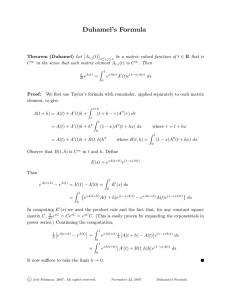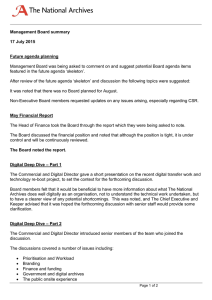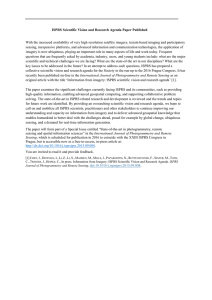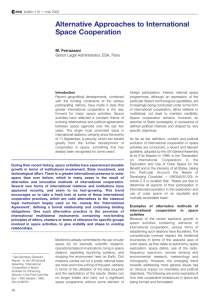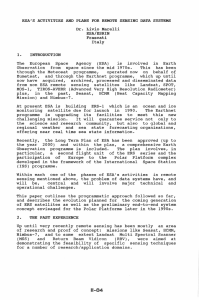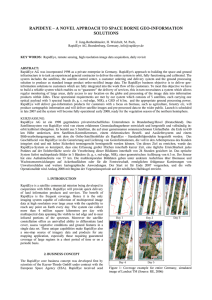Report on Earth Observation Forum, ISPRS Congress, Melbourne, 2013
advertisement
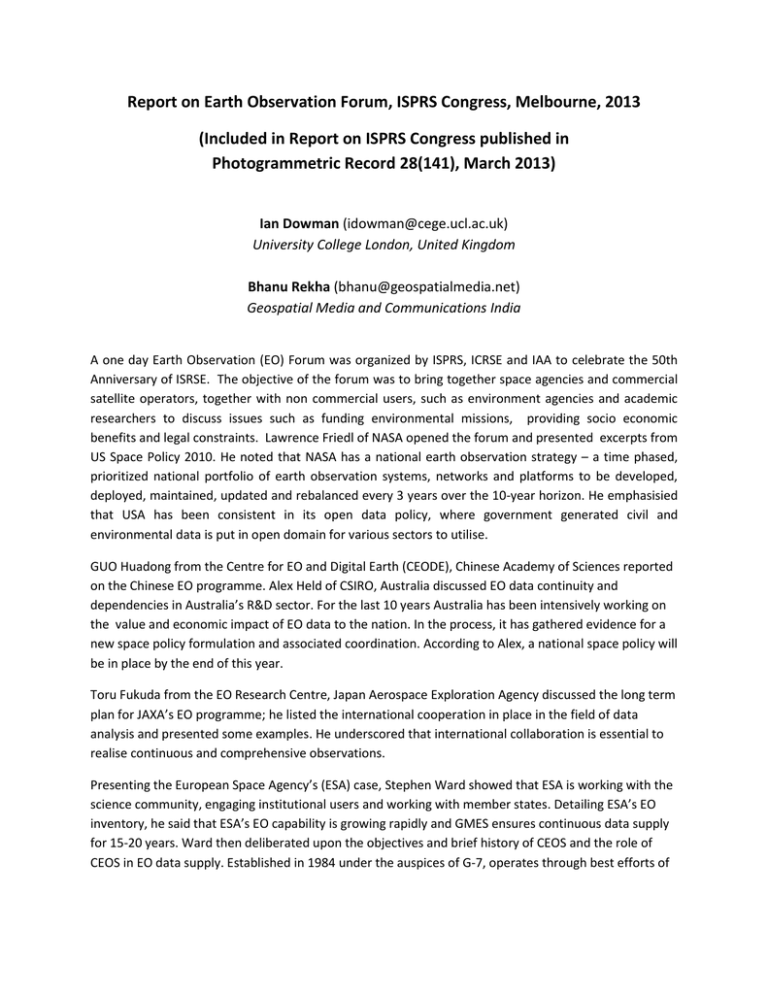
Report on Earth Observation Forum, ISPRS Congress, Melbourne, 2013 (Included in Report on ISPRS Congress published in Photogrammetric Record 28(141), March 2013) Ian Dowman (idowman@cege.ucl.ac.uk) University College London, United Kingdom Bhanu Rekha (bhanu@geospatialmedia.net) Geospatial Media and Communications India A one day Earth Observation (EO) Forum was organized by ISPRS, ICRSE and IAA to celebrate the 50th Anniversary of ISRSE. The objective of the forum was to bring together space agencies and commercial satellite operators, together with non commercial users, such as environment agencies and academic researchers to discuss issues such as funding environmental missions, providing socio economic benefits and legal constraints. Lawrence Friedl of NASA opened the forum and presented excerpts from US Space Policy 2010. He noted that NASA has a national earth observation strategy – a time phased, prioritized national portfolio of earth observation systems, networks and platforms to be developed, deployed, maintained, updated and rebalanced every 3 years over the 10-year horizon. He emphasisied that USA has been consistent in its open data policy, where government generated civil and environmental data is put in open domain for various sectors to utilise. GUO Huadong from the Centre for EO and Digital Earth (CEODE), Chinese Academy of Sciences reported on the Chinese EO programme. Alex Held of CSIRO, Australia discussed EO data continuity and dependencies in Australia’s R&D sector. For the last 10 years Australia has been intensively working on the value and economic impact of EO data to the nation. In the process, it has gathered evidence for a new space policy formulation and associated coordination. According to Alex, a national space policy will be in place by the end of this year. Toru Fukuda from the EO Research Centre, Japan Aerospace Exploration Agency discussed the long term plan for JAXA’s EO programme; he listed the international cooperation in place in the field of data analysis and presented some examples. He underscored that international collaboration is essential to realise continuous and comprehensive observations. Presenting the European Space Agency’s (ESA) case, Stephen Ward showed that ESA is working with the science community, engaging institutional users and working with member states. Detailing ESA’s EO inventory, he said that ESA’s EO capability is growing rapidly and GMES ensures continuous data supply for 15-20 years. Ward then deliberated upon the objectives and brief history of CEOS and the role of CEOS in EO data supply. Established in 1984 under the auspices of G-7, operates through best efforts of members and associates via voluntary contributions. CEOS is optimising the benefits of space borne earth observations through cooperation among its members. Presenting a media perspective on the way forward for commercial EO industry, Bhanu Rekha from Geospatial Media and Communications, India discussed the recent developments in commercial space including the takeover of RapidEye, merger of DigitalGlobe and GeoEye and the budget cuts and the implications. Urging the community to change the business strategy, she said industry needs to be driven by market policies of demand and supply, nurture commercial applications and create applications for small and medium users in other economic industries like agriculture, telecom, insurance and mining. Gary Homes from DMCii in the UK discussed the DMCii constellation and said DMC follows a unique concept of international partnership combining national objectives, commercial applications and humanitarian aid. John Ahlrichs, VP International Sales, RapidEye AG brought in collaborative thoughts in a competitive world. He advocated new partnerships, collaborations to leverage each others’ strengths and create new opportunities. Rainer Sandau, Director of IAA enumerated the International Academy of Astronautics’s history and activities. He also listed the top priorities for IAA in 2012-13 and noted that the academy is working on concrete projects, studies, pilot projects etc on themes like robotic space exploration, human spaceflight, disaster management and climate change. Advances in the use of RS and geoinformation technology in nuclear non-prolifieration and arms control verification regimes were discussed by Irmgard Niemeyer from the Nuclear Safeguards Group, Institute Of Energy And Climate Research, Germany. Citing examples, she explained how satellite imagery is used extensively for verification and scrutiny purposes under various international and regional treaties. With the help of beautiful imagery, Mario Hernandez, UNESCO, Paris described how GIS and EO data are used to preserve world heritage sites. He cited several examples of monitoring heritage sites where several remote sensing techniques including LiDAR, radar and optical imagery are used. Adam Lewis, Geoscience Australia enumerated how the Australian government is using commercial EO capabilities. Talking on earth observation for science and public use, Gunter Schreier of DLR shared the experiences, rules and plans of the International Charter on Space and Major Disasters. Initiated by ESA and CNES in 1999, the Charter is an international agreement among space agencies to support with space based data and information relief efforts in the event of emergencies caused by major disasters. He concluded saying that there is need for free and open data policy to cope with societal challenges, going beyond commercial drivers. It is important to harmonise national policies in granting or denying access to data and move towards international solutions to obtain sustainable and stable conditions for long term observations. The presentations were followed by a panel discussion where lively interaction ensued and several important issues facing the earth observation industry were discussed. The panel noted that the major advances in the last four years were the increase in the availability of data and that dealing with big data would be a major problem in the next four years. Access to data through clarity on data policy had improved but there was a need for easier data sharing. There is still a need for more promotion of remote sensing and potential applications but it was noted that in some areas, such as forestry and agriculture, the use of Earth observation is quite mature. Energy and insurance were areas noted as emerging disciplines for using remote sensing. It was also noted that there is an increasing need for stereo data. The forum was followed by a reception marking 50 years of the Symposium on Remote Sensing of Environment, the first Symposium was convened in 1962 in Ann Arbor, Michigan.


